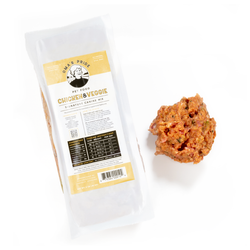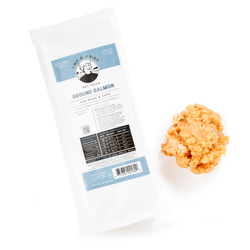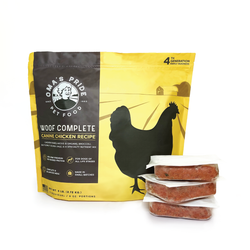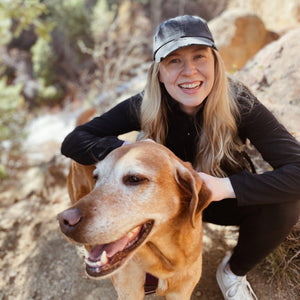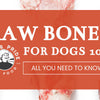Raw Dog Food: Why HPP Isn’t the Best Option (High-Pressure Pasteurization)
One of the biggest concerns that pet parents have when feeding raw food is food safety.
People wonder, “Will my dog or cat get sick from raw meat?” “What’s the best pathogen mitigation process to keep my pet safe?”
Answering these questions is very important, but finding information can be overwhelming. Today, I’m here to explain why bacteriophaging is a better option than HPP dog food (high-pressure pasteurization) for maintaining the nutritional integrity of raw pet food and feeding the most nutrients possible.
Tip! Oma's Pride, a 4th-generation USA business, crafts raw pet food using bacteriophaging (a superior, natural technology to reduce or eliminate the presence of disease-causing bacteria). Check out our bestselling products!
Explore Products
Table of Contents
- Why raw food diets are appropriate for cats and dogs
- Comparing different raw pet food pathogen mitigation techniques
- Deep-dive: HPP Dog Food
- Deep-dive: Bacteriophaging
- Extra note about kibble and bacteria
- Summarizing raw food safety
- Oma's Pride raw pet food and bacteriophaging
- Frequently asked questions
Raw food diets—biologically appropriate for cats and dogs

Before we discuss raw pet food pathogen mitigation techniques, let’s discuss why raw food is optimal for cats and dogs (compared to highly processed kibble or cooked meat).
Dogs and cats are carnivores built to process raw meat as an ideal diet. While humans will get sick when consuming raw meat like beef, carnivores are anatomically equipped to eat raw meat safely.
Did you know? Canine and feline stomachs are naturally inhospitable for bacteria because they're highly acidic (high levels of hydrochloric acid). They also have short GI tracts, sharp canine teeth, and jaws designed to chew and rip meat.
Scientific studies have found that pets eating raw diets experience better digestion than those who eat cooked meat. While we might think that cooked meat is “safer” for cats and dogs, the cooking process can negatively impact the nutritional quality of pet food.
A raw diet can also benefit a dog's lifespan, energy, skin, coat, teeth, and overall mood.
Pathogen mitigation techniques for raw pet food

Both pet and human food manufacturers use pathogen mitigation techniques when processing food to ensure that consumers aren’t exposed to harmful bacteria.
However, not all techniques are equal when it comes to raw pet food. While some methods seek to kill all bacteria (good and bad), others aim to eliminate harmful bacteria while maintaining the full nutritional value of raw food.
Did you know? Dogs and cats are carnivores who “can handle significant bacterial loads from food…the type of bacteria he or she would encounter by eating wild prey…Their stomachs are naturally so highly acidic there aren’t many organisms that can survive it. Dogs and cats also produce a tremendous amount of bile, which is both antiparasitic and antipathogenic.” (Dr. Becker)
The truth is, we don’t live in a perfectly sterile world (nor would we want to). Our pets benefit from fresh, whole foods with enzymes and healthy bacteria to support gut health, digestion, and longevity.
When striving to keep our pets safe from harmful bacteria, we don’t want to eliminate much-needed nutrients from their diets. That’s why it’s important to know what technique is used on your pet’s food—so that you can make the most informed decision.
Next, we’ll discuss the key differences between HPP and bacteriophaging, two pathogen mitigation techniques used in raw pet food manufacturing.
Deep-dive: HPP Dog Food
HPP (high-pressure pasteurization) is a sterilization technique that is commonly used in pet food manufacturing.
Here’s how HPP works: raw food is first covered with cold water. Then, pressure is added until the bacteria denatures (in other words, is destroyed). This process breaks apart the DNA in the bacteria, causing the bacteria to die.
Did you know this about HPP? “To understand the amount of pressure applied to HPP foods…let’s compare it to the Mariana Trench. That’s the deepest place on earth. It’s nearly 11,000 meters below sea level and deeper than Mount Everest is tall. The pressure of most HPP foods is about 5 times the pressure in the Mariana Trench” (source).
Concerns with HPP
The main disadvantage with HPP is that both good and harmful bacteria are destroyed using the high-pressure process since all bacteria denature at the same pressure. That’s why it is not optimal when raw food undergoes high-pressure processing compared to bacteriophaging.
While research varies, it is generally accepted that HPP can impact nutritional integrity, texture, palatability, and even color or smell in some cases. HPP has also been noted to create slight deficiencies in nutrients like vitamin A, B12, pantothenic acid, and pyridoxine.
Keep in mind that not all HPP is exactly the same. Some companies use cold water to pasteurize, while others use warm or hot water. Warm water will impact food more than cold water.
To summarize: The goal of HPP is the creation of a sterile and bacteria-free food. We believe the best raw food for pets contains all naturally occurring enzymes, probiotics, and beneficial bacteria. This makes the HPP process less optimal than a more natural process, like bacteriophaging.
Deep-dive: Bacteriophaging
Unlike HPP, bacteriophaging is a pathogen mitigation technique that maintains the full nutritional value of raw food.
Bacteriophage means bacteria-eater. Bacteriophages are “the oldest known organisms on this planet, probably existed around three billion years ago, and are arguably the most ubiquitous organisms on earth” (Dr. Alexander Sulakvelidze).
In simple terms, bacteriophages are naturally occurring viruses that eat bacteria. While they are harmless to humans and animals, they function to target and eliminate bacteria.
In humans, bacteriophages aid in getting rid of certain kinds of bacteria that we don’t want around the body or that make us sick. The same principle can be applied to pet food.
Why Bacteriophaging is a Superior Pathogen Mitigation Method
Unlike HPP, bacteriophaging is specific: “They only kill targeted bacteria…[because] we don’t want to eliminate all bacteria…Many types of bacteria are good for us, so we really need to find a much more targeted and gentle approach that will kill disease-causing bacteria without killing good bacteria. Bacteriophages allow us to do that” (Dr. Alexander Sulakvelidze).
In other words, phages preserve the full nutritional quality of food. They eliminate undesirable bacteria while leaving positive bacteria untouched.
That’s why phages are considered natural and non-GMO: “The whole concept is so sophisticated and pure…that the bacteriophage preparations are kosher, they are halal, they are OMRI listed, which means that they are suitable for organic food production. All we do is put them in the right concentration in the right place” (Dr. Alexander Sulakvelidze).
Did you know? At Oma’s Pride, we bacteriophage our raw pet food to reduce or eliminate the presence of disease-causing bacteria (salmonella, E. coli, and listeria) while preserving the integrity of our truly raw food. The healthy bacteria in our foods remain intact to support your pet’s microflora and gut. It’s all of the good raw nutrients without the bad bacteria.
Bacteriophages are a trusted technology in human and pet food production. In fact, they are approved by the FDA as pathogen mitigation methods for food. Phages are GRAS (generally recognized as safe) by the FDA as well.
Extra Note: Why Kibble is Not “Sterile”
When discussing raw pet food safety, it’s essential to note that alternatives like kibble or highly-processed foods are not sterile or “bacteria-free.” In fact, most recalls (especially for salmonella) happen in kibble production, not raw production.
“[As an example] kibble manufacturers have recalled 149,948,840 lbs of kibble. In the same period of time, 1,986,035 lbs of raw food have been recalled. That means kibble has been recalled 75 times more than raw [during one 7-year period]! Essentially, for every one pound of raw that was recalled, 75 pounds of kibble was recalled” (source).
Of course, every pet parent is concerned about safety. However, thinking that processed or highly heated food (typically made from sub-optimal ingredients) is automatically safe is incorrect.
The better option for safety and nutrition is feeding real, whole foods filled with healthy bacteria processed using a natural pathogen mitigation method, like bacteriophaging.
Summarizing Raw Food Safety
To summarize, dogs and cats are carnivores anatomically and biologically equipped to eat raw meat safely.
When it comes to pathogen mitigation and raw pet food, bacteriophaging is a superior method because it doesn’t change the integrity of raw food. Instead, phages target and eliminate only harmful bacteria while leaving beneficial bacteria alive.
On the other hand, HPP uses immense pressure to kill bacteria in pet food (good and bad bacteria). It is a less natural, more intrusive technique compared to bacteriophaging.
Decrease the Risk of Sickness from Pet Food
While we don’t live in a completely sterile world, we can implement preventative measures to decrease the risk of illness drastically. A few preventative measures include:
-
Follow safe food handling techniques. When handling raw meat for yourself or your pet, follow best practices such as washing hands properly, sanitizing surfaces, keeping raw and cooked foods separate, and not touching hands or mouth. These best practices will help you avoid illness.
-
Buy food from free-range, grass-fed sources. Grass-fed and free-range meat contains “a lower bacterial content than animals raised in confinement. ‘Due to the stress of living in confinement…animals are exposed to a much higher level of bacterial contamination. [For example], corn fed to cattle changes the gut pH, which favors growing conditions for pathogenic E. coli, which are shed in the feces the animals stand in’” (source). If you source meat naturally from small family farms, you reduce the risk of exposure to harmful bacteria.
-
Bacteriophage raw pet food. As we’ve mentioned in this article, a natural pathogen mitigation process can eliminate bad bacteria (salmonella, listeria, and E. coli) without killing beneficial bacteria to support your pet’s microflora and gut. Investigate what method your raw pet food manufacturer uses to ensure they use the best technique.
Oma’s Pride Uses Bacteriophaging for Raw Pet Food
Named for our beloved matriarch, Margaret “Oma” Miller, we are a fourth-generation family-owned and operated raw pet food company built in the USA. We use only human-grade ingredients, do not HPP our food, and make everything in small batches in a USDA facility.
We pride ourselves on helping pets live their fullest lives through optimal carnivore-focused raw food diets. Our commitment to crafting an extensive catalog of raw food, freeze-dried products, bones, and supplements for cats and dogs is a generations-old family value.

Our Raw Food Philosophy
We believe that the key to our pets living long, healthy, and happy lives starts in their bowl. Biologically appropriate and consistent with the digestive makeup of their ancestors, diets should always be raw to preserve crucial enzymes and nutrient composition.
That’s why we choose bacteriophaging to reduce or eliminate the presence of disease-causing bacteria (salmonella, E. coli, and listeria). The bacteriophage process leaves only beneficial bacteria in the meat to preserve its raw nutritional integrity.
Frequently Asked Questions
I've heard that HPP doesn’t alter raw pet food significantly. Is this true?
Some will argue that HPP nutritionally changes raw food minimally, so it doesn't make a big difference. However, we know that HPP does alter certain nutritional aspects of the food.
Better options are available, like bacteriophaging. We believe that bacteriophaging is the future of raw pet food pathogen mitigation to maintain the integrity of raw food better than HPP.
Why is bacteriophaging better than HPP?
Bacteriophaging is better than HPP for eliminating harmful bacteria in raw pet food because it targets and kills only unwanted bacteria while leaving beneficial bacteria unharmed. HPP, on the other hand, indiscriminately kills all bacteria using high pressure.
What phages does Oma’s Pride use on raw pet food?
Oma’s Pride uses phage sprays that target salmonella, listeria, and E. coli, which are three harmful bacteria potentially found in raw meat.
Leave a comment
Your email address will not be published. Required fields are marked with *
